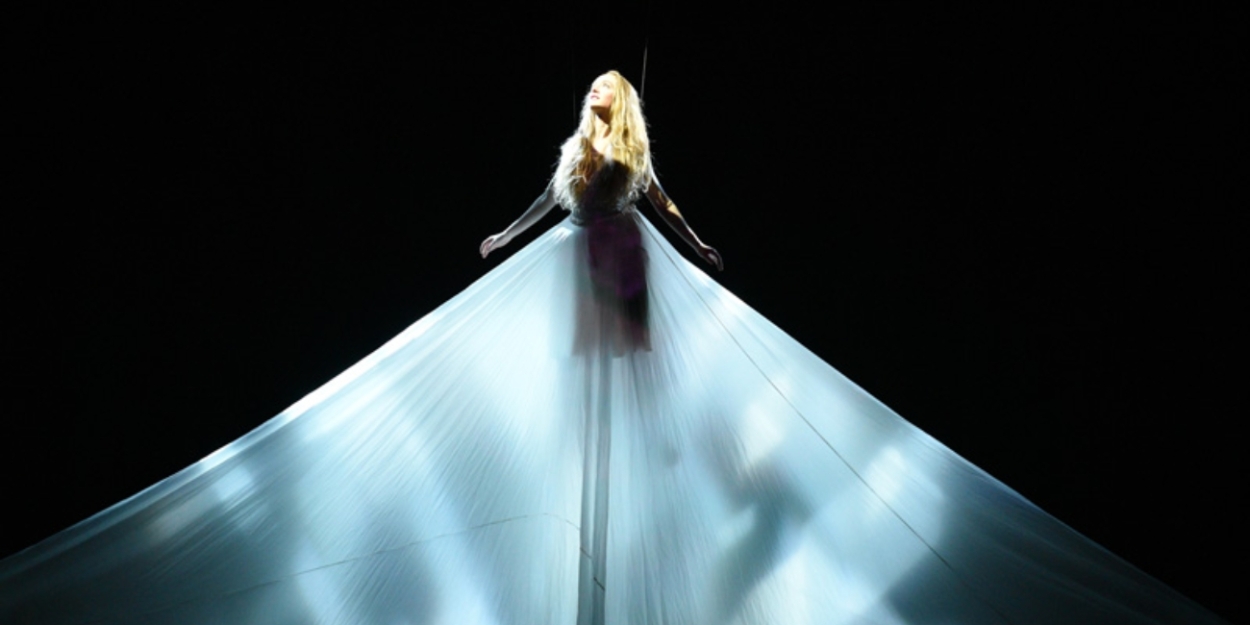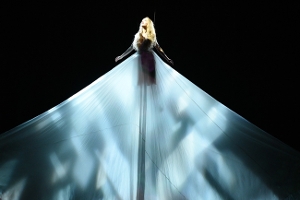Interview: Moses Pendleton talks ALICE coming to Bass Concert Hall
Momix sends audiences flying down the rabbit hole in Moses Pendleton’s ALICE


An upcoming tour of Momix’s ALICE is headed to Austin next week, and we’re in for a treat. Momix's productions, choreographed and directed by the brilliant Moses Pendleton, have been performed all over the world, captivating audiences with their dreamlike and fantastical storytelling through movement and imagery.
Pendleton is a choreographer and dancer known for his innovative and visually stunning work in the world of modern dance and his history with Momix begins with the formation of the company itself. In 1981, he co-founded Momix, a contemporary dance company that quickly gained international acclaim for its unique and imaginative approach to dance. The name "Momix" is derived from a combination of "Moses" and "remix," reflecting Pendleton's central role in shaping the company's artistic direction.
Under Pendleton's direction, Momix is known for its fusion of dance, illusion, and visual effects. The company's performances often incorporate elements such as innovative lighting, props, and costumes to create surreal and otherworldly landscapes on stage.
Pendleton's work with Momix has left an indelible mark on the world of contemporary dance, pushing the boundaries of what is possible on stage and captivating audiences with imaginative and visually stunning performances. His career has been defined by a commitment to artistic innovation and a passion for creating dance experiences that are both thought-provoking and visually spectacular. I had a chance to visit with Moses earlier this week about his work and the touring production of ALICE.
Tell us about your trajectory from being raised on a farm to being a cutting edge innovative choreographer.
Well I wouldn't have been a cutting edge choreographer if I hadn't got started out on the farm. I found my soul in the soil. And I've really never left the farm. I consider the natural world, my inspiration: the plant, the animal, the mineral, and how it inspires the human and is connected to the human. It was part of my background as a farm boy, more in northern Vermont, I had a lot of experience with plants and forms in nature. Forms in nature did inform me and I suppose it reflects itself in the shows and the work that I do.
It was a series of accidents that got me through life and how I deal with them so far, you know, different surprises and different turns in the road that I didn't expect. And the basic thing about that is you just gotta go with the flow, go with the flow-er. You've got to be in a way like water, and change and adapt and, and that's how it is.
I wonder if your answer to the previous question would have been different 20 or 30 years ago?
I probably would have had some kind of wise-assed comment, and to try to show how witty I was — that's what I probably would have done back then. I've never really told the truth — as long as it was rhythmical, the lies seemed to pour right out of my head because I was very much into fiction and the reality of fantasy. Maybe just a reflection of the need to escape from all the real world, into the world of art and theatre and entertainment in the surreal — the day dream. And I was always kind of running away from the real issues of life. Fortunately, I was able to, in the early days with Pilobolus and the last 43 years, Momix, make a living out of that philosophy, out of that curiosity. I was energized by the surreal, by the dream, by the exploration of the unconscious. You know, this is something I've always been interested in, I guess. A piece like ALICE fits into that notion, in terms of the surreal, the logic of illogic. All of that seems quite a nice fit for me.
Could you tell those of us who would typically go to theatre or enjoy film, how we would experience a Momix performance?
Well, I think “mix” in the word Momix is key. Momix is not any one particular thing but a mix — it’s an alchemical metaphor — it's putting dance, circus tricks, illusionist theatre, making connections to other images, architecture, lots of different things, and using a mix of sound and light and various staging to create kind of an experience that is physical and sensual, surprising and unusual. But it's not any one particular thing.
It’s more physical, visual theatre. I think it's more the idea of how all of those elements, the body, the visual, the light, the costumes, the spectacle, and also a kind of musicality, that allows people to watch. That's where the dance comes in. Sometimes it doesn't really tell a story, but it's rich in images that you may get, and all we were trying to do with Momix is to get people to not fall asleep while we're doing it, that it engages you and is very imaginative. I think that perhaps if the audience goes away from the show with a little less gravity in their step then it's been a success.
I've always been involved in energy and theatre by the way. Before Pilobolus, our show up in Vermont was called the Vermont Natural Energy Theatre. We used to call ourselves an energy circus. So there's an element of circus and physical theatre. Some of my background in the early days was Julian Beck, Joseph Chaiken and Peter Schuman. These were physical theatre directors that I was very involved with and inspired by. This kind of theatre was very physical.
I didn't go to the ballet camp or down to the city to study ballet as a farm boy with an Agra background each summer. I went out to Mount Hood, Oregon, skied on a glacier with the Austrian ski team. I had a very physical education and understood how a body can move. As an athlete I actually went to Dartmouth to be a member of the ski team and that was my primary interest of study. Not just to study at a good school, but to study with the master of cross country skiing, nordic skiing, Al Merrill. He was the US Olympic coach. And I was trained to express myself with my body so there is that connection between the athletic and putting an aesthetic to that athletic. And that's kind of where we are now.
The beautiful distinction about your work and any other sort of art that has boundaries we think should be relegated to it, is that you have successfully escaped those.
So far. They haven't caught me yet. You know the world is filled with a horrifying reality and there's all kinds of things that perhaps could inspire art and creativity but I’ve always taken the position of saying not how the world is, but how it might be in a fantasy. I feel obligated to show a positive experience of energy and imagination, and something that is inspiring. When I go in and look at a new work, it has to have something to do with this positive experience, rather than pulling out my dirty laundry, which I have a lot of. Hopefully everybody can be as abhorred by it as I am. I edit some of that out for my own health, education and welfare. You have to be disciplined not to let your own neurosis take over your art.
There's also a certain kind of humor to facts that I like to play with and if it makes people smile or laugh, then I figure it has a chance for a call back in this gorgeous world that we're involved in.
What can we expect when we attend ALICE?
In ALICE there are 25 separate pieces that have their own life, yet it should hopefully move and have a decent musical curve in the evening. And there’s our use of props. I see myself as a visual artist or sculptor or a painter that creates imagery in collaboration with some wild, spirited, dancers. As collaborators we take the idea of a child's play for adults. You need to open up the mind and spirit and find some of that magic. Simple props, you know, barrels and flashlights.That's nothing very high tech, but it’s something that is part of the aesthetic of moments. In ALICE, we have some video and production value that is perhaps a little more advanced than other shows.
How do you remain inspired?
I try to stay focused on my health for one thing. Just before talking to you I did an hour in a cool mountain lake which I do every day. I'm inspired by taking bike rides and long swims and reading a line or two from Neruda to jump start my imagination. Then I go ahead and dig a little bit under my reality, and then see where that takes me. But you have to be careful, because if you go too far, there's a subtle difference between an artist and a madman. I guess you need to have that umbilical cord to pull you back, which is your art and your work, of course — to take all the things and desires and the interests you have and channel it and put it into something that you call your art, your work. That’s been very therapeutic, very essential to keeping my positive attitude here. 74 and pushing, still, pushing, you know.
I’ve been reading a very interesting book about the latter years of creative people. There's some chapters on Monet and Matisse and a few others and how they stayed active and energetic and, in fact, stayed alive for a long time up into the mid eighties, because they kept creating. Part of what I do is, is a survival idea that can't just retire.
In fact, when I didn't go to business school or become a doctor or a veterinarian (I got into Pilobolus at 20) which was retiring at an early age in order to really enjoy my eventual senility after this retirement — to escape into the aesthetics of whatever it is that might paint a picture in your day that you would be excited to see in a painting or a photograph.
What inspired Alice?
Well, Alice inspired Alice.
I memorized the Disney film. I don't know if I ever read the book as a young child, but I did watch the Disney interpretation of it. I did a lot of research during the making of this piece to see that Carol's ultimate aim for his book wasn't for people to read it, but for it to be experienced, you know, in a three dimensional musical theatre. And in fact, there are a hundred productions of Alice in Wonderland, most of them in England, that he oversaw. Alice was really something to be interpreted.
We would never have known Alice at all today if it wasn't for a very remarkable illustrator named John Tenniel, who you may have heard of, but he illustrated the first Alice in Wonderland and many people got quite involved in the book because of the illustrations. I've often said with Alice that I was just gonna read the book and copy the book onto the stage if that's even possible.I always use the example of Salvador Dali, who was commissioned to do twelve paintings on the theme of Alice in Wonderland.I must say, if you didn't know that that's what they are, you would have probably no idea what you're looking at. And that's perfect for me, because we've taken a lot of liberties with what people perhaps know before they even come to the show.
We all have some idea of the iconic Alice, The Cheshire Cat and the Mad Hatter and what have you and II use our alchemical retort as a way of throwing in impressions of Alice and then having it come out as a Momix show called ALICE, you know.
I half jokingly say that there are many times at the end of the show I’ve had all these disgruntled Alice Cooper fans that came and said they didn't see or hear any Alice Cooper music. I really enjoy that because it is called ALICE not Alice in Wonderland or Alice Underground or anything. We’ve taken a lot of liberties with it. It’s a kind of rabbit hole of our own making and we're inviting people to jump into it and get into it. But it is a kind of Momix show using Alice as a theme, rather than literally trying to interpret it.
I think Lewis Carroll might even, if he were alive today, have added a couple more chapters to his book after watching Momix. We keep going with it. I thought, in a very simplistic, half humorous way that the best way to do Alice is just get some of our Momix girls in little white, tattered dresses, and that's it. They look like Alice, let’s see what they do. We have elements of scale and surreal, nonsense, visual puns and the humor that Lewis Carroll has. He was also a great photographer, actually, and primarily my interest now is photography. So I felt a lot of kinship with him.
It gets interesting every time we take on a new project. A lot of the research actually gives you some ideas for future projects and that's KIND of how we see Alice, again, not the real hardcore Alice in Wonderland. Lewis Carol aficionados might get upset in the show saying. “Where's the trials? Where's what we saw on Disney?” And even Disney, as you know, didn't just take Alice in Wonderland. He mixed up the Looking Glass and Alice in Wonderland. Tim Burton did it, you know, a pretty interesting film. But they took off and made up their own sections and changed things around. It lends itself for interpretation by whoever is doing it, and has been interpreted both literally, poetically, artistically, and theatrically for many years. We're in that tradition, I think.
Momix sends audiences flying down the rabbit hole in Moses Pendleton’s newest creation, ALICE inspired by Lewis Carroll’s classic Alice in Wonderland. ALICE is in town for one night only, September 20, at 7:00pm. Immediately following the performance, ticket holders are invited to stay and talk with members of the company. Get your tickets here.
Comments
Videos
